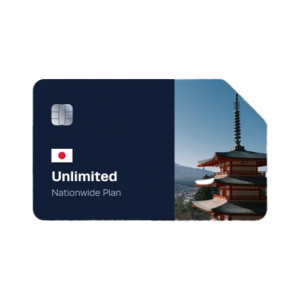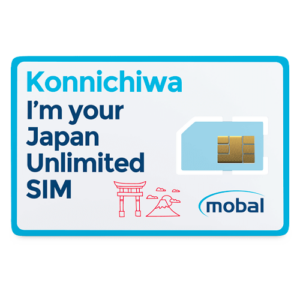Make your next Japan trip – whether it’s for business or relaxation – pure pleasure with our guide to the best SIM cards for travelling in Japan.
The best SIM cards for travelling to Japan
Roaming in Japan, or 日本で国際ローミング

Japan has been an important trading partner for Australia for many decades, so many businesspeople will find a need to head to Tokyo on a regular basis. Moreover, it’s also one of the most often-cited desired travel destinations for Australian holidaymakers, whether you’re getting seriously into Japanese cuisine in Osaka or hitting the snow slopes in Hokkaido.
While you don’t have to shift too many time zones – or for Western Australia, any time zones at all – to travel to Japan, one factor you should take into account is how you’re going to manage your mobile connectivity while you’re there. There’s no absolute “best fit” solution that works for everyone, so this article will run through your best choices across standard travel SIMs, travel eSIMs, roaming and local telco choices:

Best Japan eSIM you can purchase globally
Jetpac
Disclaimer: This pack only offers data roaming. No calls or SMS are included in the plan price.
Most Australians are familiar with the telco Circles.Life. The Optus 4G Plus-powered SIM provider has taken Australia by storm with some ridiculous deals on mobile data. Well, Jetpac is the company's foray into the global Travel eSIM market, a singular solution for frequent flyers that's available in over 100 different countries. So long as you've got an eSIM-compatible phone, you can purchase and activate a Jetpac eSIM from anywhere in the world.
Jetpac's Japan eSIM is actually no different from its Asia Pacific eSIM. So not only can it be used nationwide in Japan, but also in 14 other popular Asia Pacific countries, including but not limited to Australia (G'day,) China, Hong Kong, India, New Zealand, the Phillippines and Thailand.
Plans start from $1.50 for 1GB with a 4-day expiry but 30-day can cost anywhere between $13.50 for 5GB or $94 for 40GB. Follow the link below for a full list of Jetpac payment plans.
eSIM Japan
Disclaimer: This pack only offers data roaming. No calls or SMS are included in the plan price.
As the name suggests, eSIM Japan provides eSIMs as its business model with a range of very competitively priced plans that work primary for short trip travellers, with most plans sold with between 3 to 12 days of validity. You can choose between “unlimited” plans – really they’re just data packs with 384kbps speed capped data once your daily quota is exhausted – or data quota deals with a fixed amount over 7, 15 or 20 days.
One oddity with eSIM Japan is that it also offers the same plans as “city” plans for many popular destinations such as Tokyo, Kyoto, Hiroshima, Osaka and Sapporo. They appear to just be the same plans as the nationwide ones, however, so it’s arguably best to stick with those.
eSIM Japan uses the KDDI network in Japan.
Best Japan Travel SIM
Mobal Short Term SIM
There’s a number of choices in the Japan Travel SIM market that you can order before you leave Australia from brands such as Sakura Mobile and B-Mobile, but if you are going the Travel SIM route it’s hard to overlook Mobal’s short-term tourist SIMs. Starting at ¥4,730 (~$50 AUD, depending on exchange rates) for an unlimited data-only 8 day SIM up to ¥7,920 (~$83) for a full 30 days with unlimited data.
It's worth noting that Japan allows a, shall we say, more “loose” definition of “unlimited” than you might think would apply, before you plan to start downloading the entire Netflix back catalogue to your tablet. Most plans are limited to 3GB of data per day, after which data speeds “may” be reduced. For most tourists being prudent 3GB a day is plenty enough, even if you are uploading most of your food and location snaps to Instagram at a frenzied pace.
Mobal’s SIMs work on the Softbank and Docomo networks in Japan with a claimed 99% population coverage, which should cover most places you’re likely to go on business or holiday within Japan.
Best Australian deal for Japan roaming
Vodafone $5 Roaming
Vodafone remains the gold standard for global roaming if what you’re after is simplicity. Simply sign up for a qualifying Vodafone postpaid plan, and you can access the inclusions on your plan while travelling throughout Japan for just $5 per day. If you don’t use your phone on a given day, there’s no charge at all, though you also don’t get any of your speed capped data if you’ve already exhausted your monthly quota. In those cases you’ll pay an additional $5 to top up 1GB of data.
Here's a selection of Vodafone plans that support $5/day international roaming
However, as with rival Optus’ $5/day deal or Telstra’s variable price “Day Pass” options, this kind of roaming within Japan can quickly add up if you’re there for a longer holiday or business trip. $5 once doesn’t feel like much, but bear in mind that over a fortnight that’s a spend of some $70 extra on top of your existing bill.
Vodafone isn’t the only telco offering roaming within Japan from your standard Australian SIM, either. Here’s a range of providers who support call, text and data roaming in Japan
Best SIM option within Japan
BIC Camera SIM
When you land in any Japanese International Airport, you’ll see a number of providers offering local SIM cards and Wi-Fi hotspot devices to tourists. They’re not a terrible deal if you want absolute convenience, but you can typically do a little better by opting for a truly local SIM card.
Only one problem here: As with many countries not all plans are sold to visitors, and your grasp of the Japanese language might be sketchy to non-existent.
Your best and most affordable bet in this case is to head to a BIC Camera store. The vast majority of Australian vistors will be landing in Tokyo, and there’s no shortage of BIC Camera stores throughout Tokyo, but also in basically every other major city as well.
Why BIC Camera? Partly the ubiquity of its stores (also fun to browse for everything from electronics to bicycles, luggage to anime figures and plenty more besides), but also because most BIC Camera stores are quite large and you’re more likely to find a staff member or two with enough English language savvy to meet your needs for a SIM when you’re there. BIC also sell other SIM cards so it’s worth checking if there’s a good seasonal deal while you’re there.
If your current handset doesn’t support eSIM, then sadly, the answer is no. There’s no magic bolt-on or software app that can add the needed virtual SIM circuitry to a phone that doesn’t support eSIM out of the box.
If your phone does support eSIMs, then it’s quite simple to set up your eSIM before you travel. We’ve got a handy guide to setting up eSIMs for Apple iPhone and Android here.
It wasn’t that long ago that the answer to that question would have been no, with public WiFi very thin on the ground even within hotel accommodation.
The Tokyo Olympics didn’t go to plan, but one factor that was planned in was a wider pitch to tourists, and this included a huge expansion of available free WiFi options. Having travelled extensively through Japan over many years, I can say that it’s better than it used to be – but it’s hardly simple, and can be a tad baffling if you don’t have a decent grasp of written Japanese for signing into web portals and such.
You could get by with a little patience and pre-planning if your accommodation offers WiFi, though. There it’s more likely to support simple sign-ins, and if you offload maps, podcasts and video content from there to keep you going, and then use the WiFi in coffee shops and some shopping centres, you might be able to do so for no additional cost. Compared to, say, travelling Europe or the USA, however, it’s still not as common or convenient, and having a decent VPN installed is a must.
Hiroshima-style Okonomiyaka, preferably prepared for you on the spot in Okonomimura in Hiroshima. Your waist might not forgive you… but it’s worth it.
Related Articles






